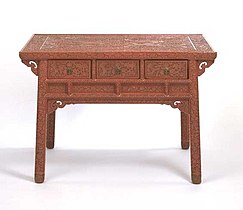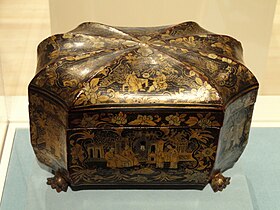Chinese culture
Chinese culture (simplified Chinese: 中华文化; traditional Chinese: 中華文化; pinyin: Zhōnghuá wénhuà) is one of the world's oldest cultures, originating thousands of years ago.[1][2] The culture prevails across a large geographical region in East Asia with Sinosphere in whole and is extremely diverse, with customs and traditions varying greatly between counties, provinces, cities, towns. The terms 'China' and the geographical landmass of 'China' have shifted across the centuries, before the name 'China' became commonplace in modernity.
This article is about Chinese culture in general. For culture in mainland China after 1949, see Culture of the People's Republic of China. For culture in Taiwan after 1949, see Culture of Taiwan.Chinese civilization is historically considered a dominant culture of East Asia.[3] With China being one of the earliest ancient civilizations, Chinese culture exerts profound influence on the philosophy, virtue, etiquette, and traditions of Asia.[4] Chinese characters, ceramics, architecture, music, dance, literature, martial arts, cuisine, arts, philosophy, etiquette, religion, politics, and history have had global influence, while its traditions and festivals are celebrated, instilled, and practiced by people around the world.[5][6]
Identity
As early as the Zhou dynasty, the Chinese government divided Chinese people into four classes: gentry, farmer, craftsman, and merchant. Gentry and farmers constituted the two major classes, while merchant and craftsmen were collected into the two minor. Theoretically, except for the position of the Emperor, nothing was hereditary.
China's majority ethnic group, the Han Chinese, are an East Asian ethnic group and nation. They constitute approximately 92% of the population of China, 95% of Taiwan (Han Taiwanese),[7] 76% of Singapore,[8] 23% of Malaysia, and about 17% of the global population, making them the world's largest ethnic group, numbering over 1.3 billion people.
In modern China, there are 56 officially labelled ethnic groups.[9] Throughout Chinese history, many non-Han foreigners like the Indo-Iranians became Han Chinese through assimilation, other groups retained their distinct ethnic identities, or faded away.[10] At the same time, the Han Chinese majority has maintained distinct linguistic and regional cultural traditions throughout the ages. The term Zhonghua minzu (simplified Chinese: 中华民族; traditional Chinese: 中華民族) has been used to describe the notion of Chinese nationalism in general. Much of the traditional identity within the community has to do with distinguishing the family name.
The characteristics of Chinese culture
The chapter discusses the contemporary situations in Chinese culture that relate to social structure, sociocultural change, and the relationship of these factors to the current state of mental health of the Chinese people. The chapter focuses on the issues of mind, body, and behavior. The cultural framework is of central concern to Chinese participants, whether they are social scientists, humanists, or clinical psychiatrists. Chinese culture appears to affect the state of body and health, parent–child interaction, social relationships, individual and group aspirations, models of health care services, and the patterns of disorders and methods of coping under the impact of migration, industrialization, and urbanization. The chapter focuses on the importance of the impact of cultural tradition upon perception, behavioral orientation, pathology, coping, and help-seeking. The mental health concerns that are relevant to the population of mainland China are related to the recent dramatic socialist revolution and particularly to the 10-year period of the Cultural Revolution.[11]
Abstract
Chinese civilization is the only one that has preserved its historical continuity among the world’s “cradles for four ancient civilizations.” In the long process of civilization evolution, the Chinese people, in the spirit of “continuous self-renewal,” “self-discipline and social commitment,” “inclusiveness to diversity,” and “realism and adaptation to changes,” created cultural traditions of abundant contents, sophisticated structures, and various forms. These traditions have since been nourishing, nurturing, and shaping the Chinese people and become internalized in the blood and soul of the Chinese nation.[12]
Leisure
A number of games and pastimes are popular within Chinese culture. The most common game is Mahjong. The same pieces are used for other styled games such as Shanghai Solitaire. Others include pai gow, pai gow poker and other bone domino games. Weiqi and xiangqi are also popular. Ethnic games like Chinese yo-yo are also part of the culture where it is performed during social events.
Qigong is the practice of spiritual, physical, and medical techniques. It is as a form of exercise and although it is commonly used among the elderly, any one of any age can practice it during their free time.





















